Blog
November 24th, 2011
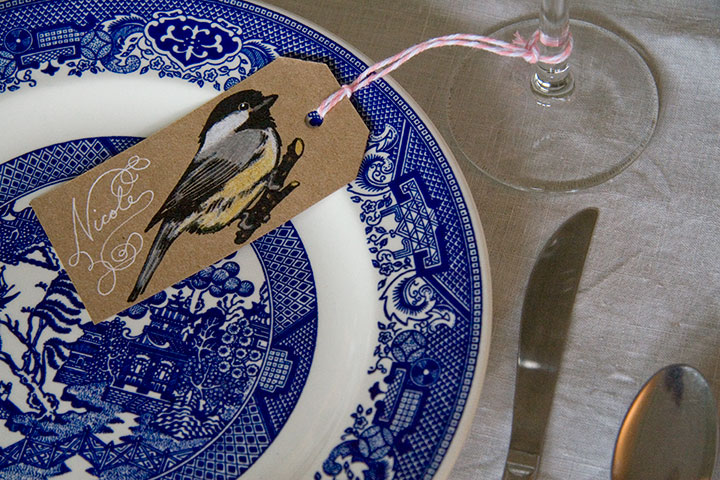
The last of our guests will be arriving any minute, and then today will be complete.
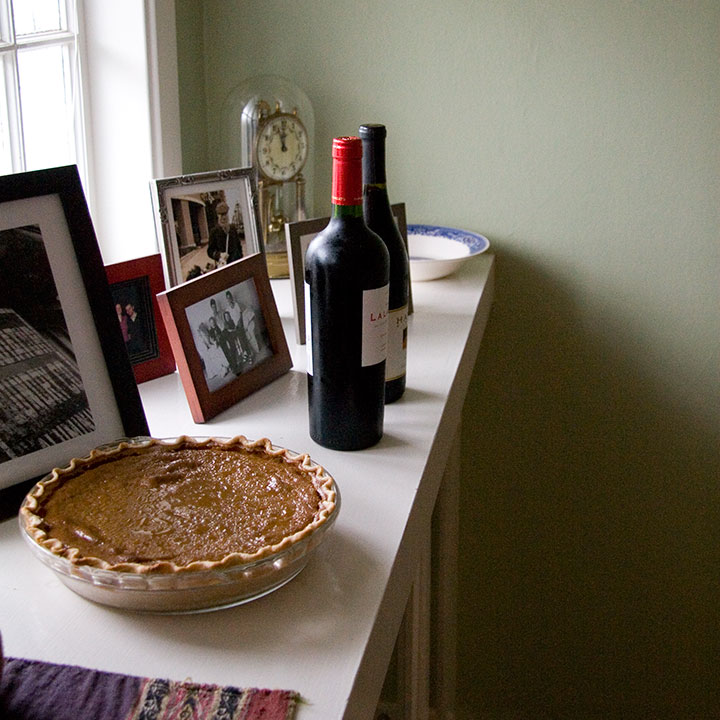
This year we have visitors who made a thousand-mile trek, bearing gifts of California wine and citrus—as well as callers just a short neighborhood stroll away, wrapped in scarves against the damp chill in the air.
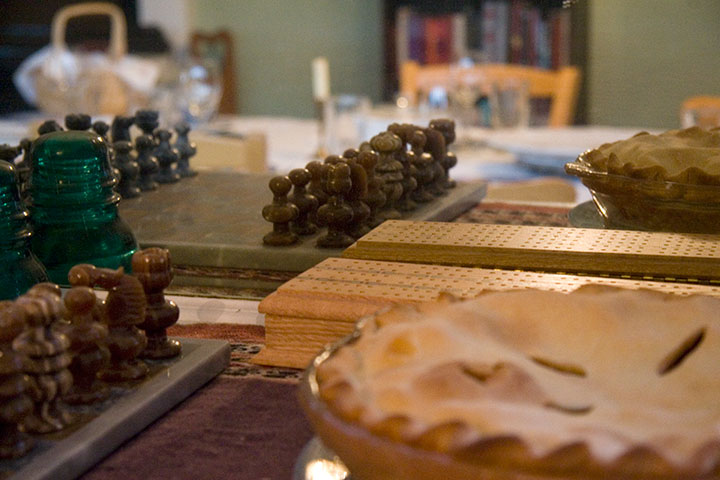
Each friend is a gift, and we raise our glasses to them in gratitude and love.
Wishing you a bountiful table with friends at every place. Happy Thanksgiving.
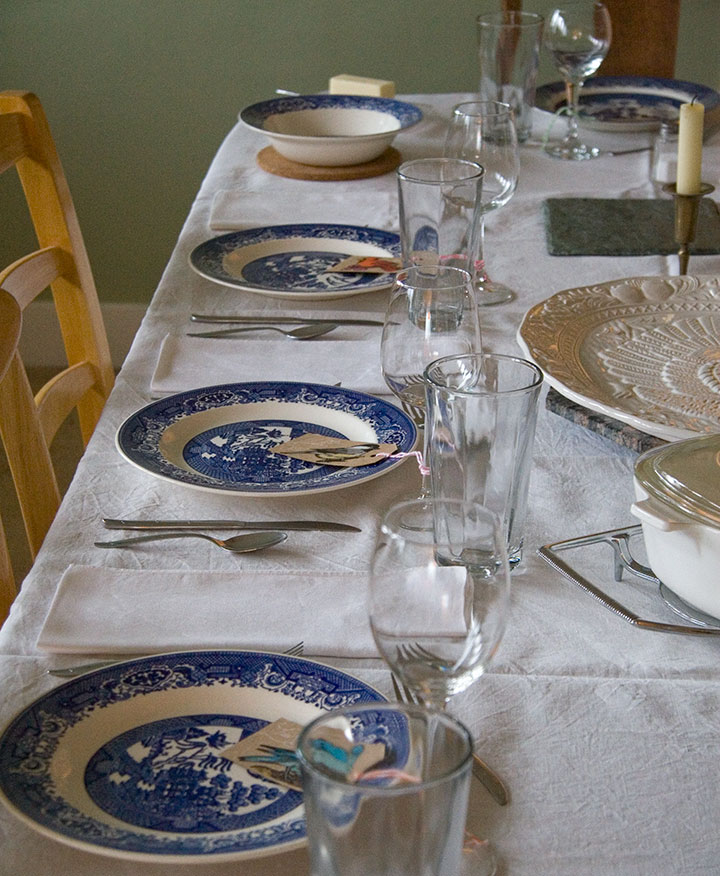
November 15th, 2011
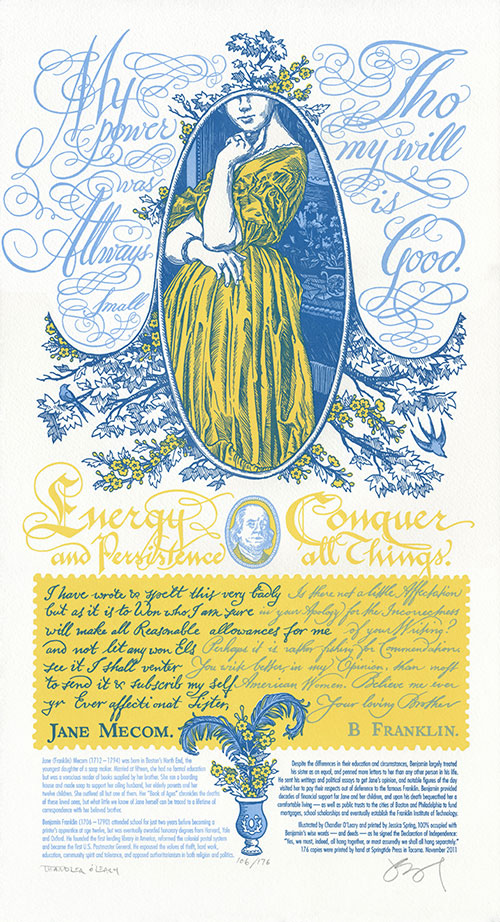
It’s hard to ignore the news of protests, ahem, occupying the attention of cities around the world—of the many and diverse thousands of people unified under one simple, yet infinitely faceted mantra. As members of the, well, vast majority of folks without any real political or financial clout in the world, Jessica and I can get behind their message—but that’s not so much the point. What really amazes us is that with a little tenacity and strength in numbers, the powerless can suddenly become very powerful, indeed.
It made us think of a woman who, despite having a famous sibling, would have disappeared into obscurity but for the simple act of picking up a pen.
My power was allways small tho my will is good. —Jane Mecom
Jane’s eminent brother, on the other hand, had a little more faith:
Energy and persistence conquer all things. —Benjamin Franklin
Jane had both energy and persistence in spades—although we marvel at how she managed it, with twelve kids, a family business and a house perpetually full of boarders to occupy her attention. Yet of Benjamin’s sixteen siblings, Jane is the only one whose story has survived the 200+ years since her death—and all because she committed her thoughts to paper. So in honor of Ben and Jane’s relationship, and in solidarity with those who find the strength to speak up, we present our first dual Dead Feminist broadside, Signed, Sealed, Soapbox.
Since this is also our first print that features a cameo from a male Dead Feminist (nope, you don’t have to be female to be a feminist), we thought it deserved a little something extra. So we set it up like a conversation—or in this case, a written correspondence. Besides, there was just so much historical ground to cover—even condensing the information to a blog post is a challenge, let alone plucking two sentences from a lifetime of dialogue. (If you haven’t already guessed, this post is a long one. Grab a cuppa if you dare to settle in!)
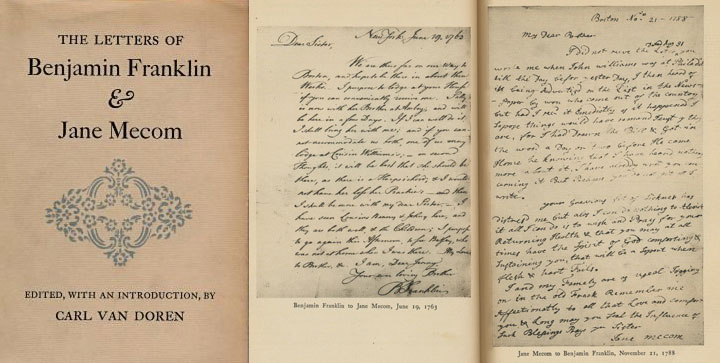
What first sent us down the Jane Mecom rabbit hole was an article about her in the New York Times, written by Jill Lepore. Lepore’s words sent me searching for more information, and I found it buried in the stacks of my local public library. I uncovered an obscure tome: The Letters of Benjamin Franklin and Jane Mecom, by Carl van Doren. The book chronicles their entire surviving correspondence—98 letters in all, printed in full. I was a little worried that the writing style of the day would make even skimming for quotes a chore—but in truth, I couldn’t put it down. It was like peering into the lives of any two ordinary people who happened to care for each other very much. There’s humor, and worried advice, and gossip, and gentle sarcasm, and the occasional scolding (usually on Jane’s part) when one or the other let too much time pass between letters. Most of all, there’s love—it’s there on every page. After all of that, we couldn’t just limit the broadside to a couple of one-liners. So the quotes are accompanied by excerpts from their actual letters, each calligraphed as closely as possible to Ben and Jane’s actual handwriting. Even the spelling errors and colonial-era grammar are intact; we figured it was better not to mess with history.

Jane’s excerpted letter:
I have wrote & spelt this very badly but as it is to Won who I am sure will make all Reasonable allowances for me and will not let any won Els see it I shall venter to send it & subscrib my Self yr Ever affectionat Sister, Jane Mecom.
Ben’s reply:
Is there not a little Affectation in your Apology for the Incorrectness of your Writing? Perhaps it is rather fishing for Commendation. You write better, in my Opinion, than most American Women. Believe me ever Your loving Brother, B. Franklin.
There are few Founding Fathers more famous than Ben Franklin, but Jane was somewhat of a mystery. What we do know is that she had a very different life than her illustrious brother. Thanks to the simple fact of having been born female, her youth was spent having babies rather than obtaining an education. Her life was marked with misfortune, poverty and the deaths of nearly everyone she loved. Yet through it all she craved knowledge, and read everything she could get her hands on. She was a skilled craftsperson, making the famed Franklin Crown Soap and teaching the trade to others. And she followed her brother’s career with pride—and he supported her in return, both financially and emotionally.
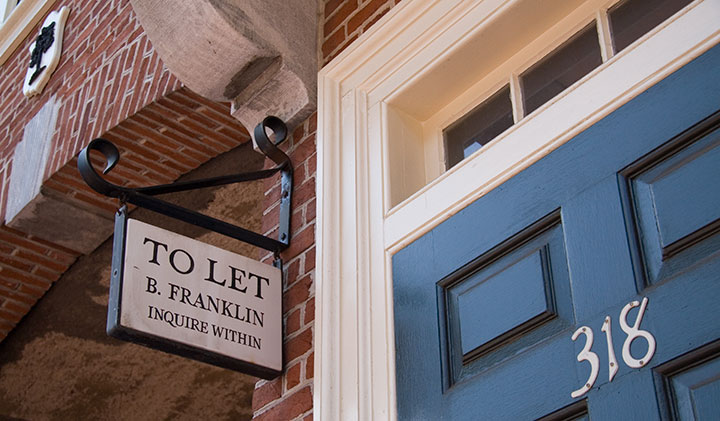
The Tailor and I spent time in both Boston and Philadelphia this summer—ye olde stomping grounds for Doctor Franklin. I had the library book of letters with me on the trip, so their words lent an interesting depth to our wanderings.
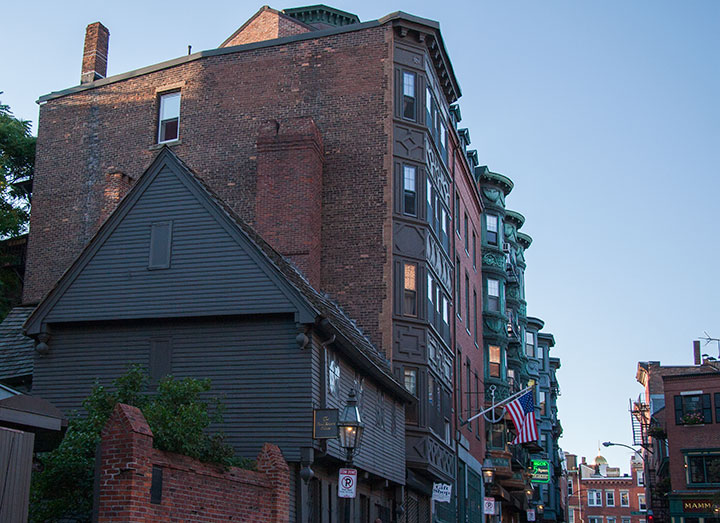
Boston is one of my hometowns, so it was there that I did the most digging. And it turned out that digging was necessary. Ben’s presence is everywhere in Philly, but in Boston, with so many Revolutionary War heroes to honor there, the Franklin family’s presence is far more subtle. And Jane? Well, she’s almost nowhere to be found.
Almost.
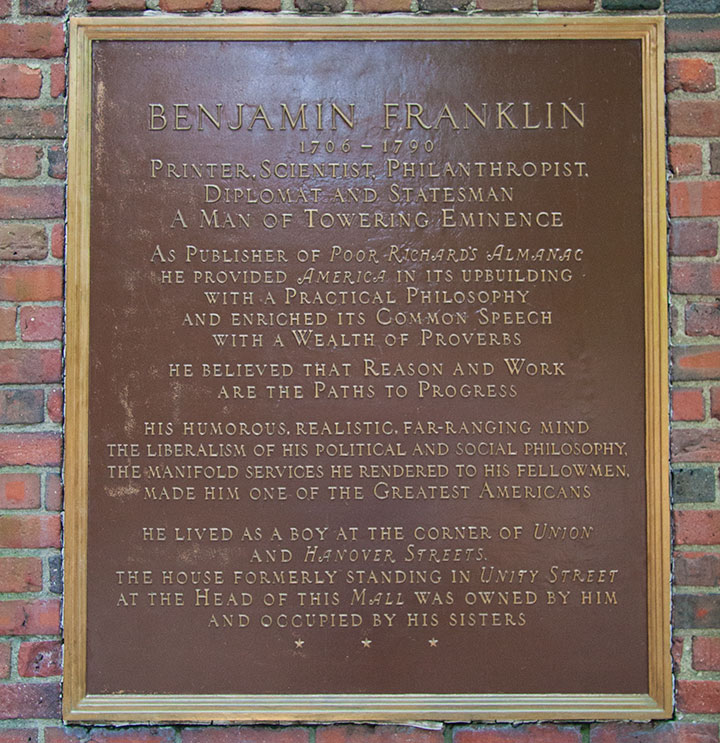
This plaque is all that’s left of the house where Jane spent all her life. It was knocked down to make room for a memorial to Paul Revere. The plaque does mention her briefly, but not by name. Another hazard of being female in the eighteenth century, I suppose.
But Jane lived through the Revolutionary war—in fact, as a resident of the North End, her home was right in the thick of it. In 1775 she fled the British-occupied city and took refuge with friends near Providence, Rhode Island. There, Ben came to rescue her. He took her to Philadelphia, where she spent a year with him before returning to a liberated Boston. While that year was full of turmoil and uncertainty for the citizens of the new United States, 1776 was quite possibly the best year of Jane’s life. For the first time in ages, she could bask in her beloved brother’s company—and he made time for her despite being busy with other things (you know, like founding our country)—and as the honored guest she was largely free from work and family duty.
As far as I can tell, it was also the last time she ever laid eyes on him. Visiting at all was a rare treat—between Ben’s high-profile career and the then-formidable distance between Boston and Philadelphia, it was impossible for them to visit one another more than a handful of times in their entire lives. And since it would have taken weeks for a letter to cross five colonies, and months to traverse the ocean to reach Ben in France, it’s a wonder they remained as close as they did all their lives. Lends a whole new meaning to “snail mail,” doesn’t it?
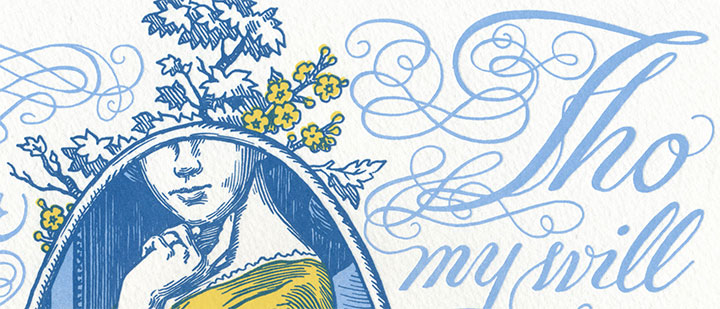
Signed, Sealed, Soapbox is illustrated with the sweeping curves of ornate penmanship and the detailed linework of colonial engravings. A faux-bois forest of branches and flowers resembles the printed toile fabrics of the day. The swoops and swirls of the calligraphy rest in stately Wedgwood blue (complimented by a telltale vase at the bottom!), while Ben and Jane’s correspondence occupies a buttery yellow letter edged like a vintage postage stamp.
And though there is no surviving likeness of Jane Mecom, she deserves so much more than the portrait of a Jane Doe. Instead, she is made in the image of The Comtesse d’Haussonville by French painter Jean-Auguste-Dominique Ingres.

Ben was the best big brother Jane could have asked for. So in honor of his positive influence, we’ll be donating a portion of our proceeds to the Puget Sound chapter of Big Brothers, Big Sisters—an organization dedicated to providing children facing adversity with mentor relationships that change their lives for the better, forever.
• • • • • • • • • • • • • • • • • • • • • • • • • • • • • • • • • • • • • • • • • • • • • • • • • • • • • • • • • • • •
Signed, Sealed, Soapbox: No. 14 in the Dead Feminists series
Edition size: 176
Poster size: 10 x 18 inches
Printed on an antique Vandercook Universal One press, on archival, 100% rag (cotton) paper. Each piece is numbered and signed by both artists.
Colophon reads:
Jane (Franklin) Mecom (1712 – 1794) was born in Boston’s North End, the youngest daughter of a soap maker. Married at fifteen, she had no formal education but was a voracious reader of books supplied by her brother. She ran a boarding house and made soap to support her ailing husband, her elderly parents and her twelve children. She outlived all but one of them. Her “Book of Ages” chronicles the deaths of these loved ones, but what little we know of Jane herself can be traced to a lifetime of correspondence with her beloved brother.
Benjamin Franklin (1706 – 1790) attended school for just two years before becoming a printer’s apprentice at age twelve, but was eventually awarded honorary degrees from Harvard, Yale and Oxford. He founded the first lending library in America, reformed the colonial postal system and became the first U.S. Postmaster General. He espoused the values of thrift, hard work, education, community spirit and tolerance, and opposed authoritarianism in both religion and politics.
Despite the differences in their education and circumstances, Benjamin largely treated his sister as an equal, and penned more letters to her than any other person in his life. He sent his writings and political essays to get Jane’s opinion, and notable figures of the day visited her to pay their respects out of deference to the famous Franklin. Benjamin provided decades of financial support for Jane and her children, and upon his death bequeathed her a comfortable living — as well as public trusts to the cities of Boston and Philadelphia to fund mortgages, school scholarships and eventually establish the Franklin Institute of Technology.
Illustrated by Chandler O’Leary and printed by Jessica Spring, 100% occupied with Benjamin’s wise words — and deeds — as he signed the Declaration of Independence: “Yes, we must, indeed, all hang together, or most assuredly we shall all hang separately.”
Available now in our new Dead Feminists shop!

November 7th, 2011
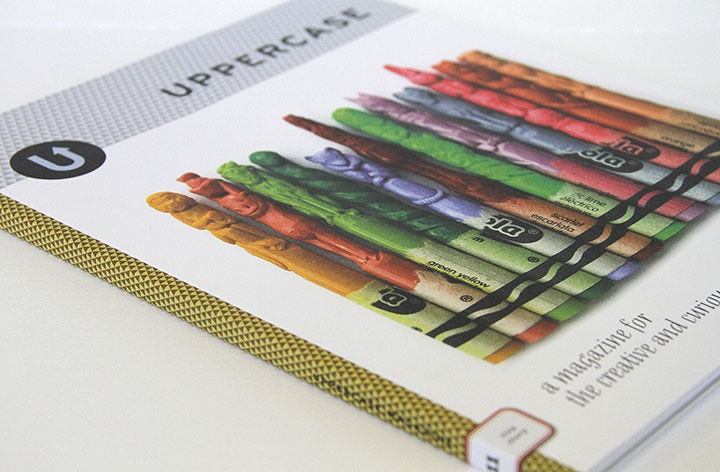
Every three months my all-time favorite magazine, Uppercase, arrives in my mailbox, and productivity in the studio comes to a screeching halt while I drool over each gorgeous page. I’ve been a subscriber since almost the very beginning (if only I could get my paws on those first two sold-out issues!), and impossibly, every new issue is even lovelier than the one before.
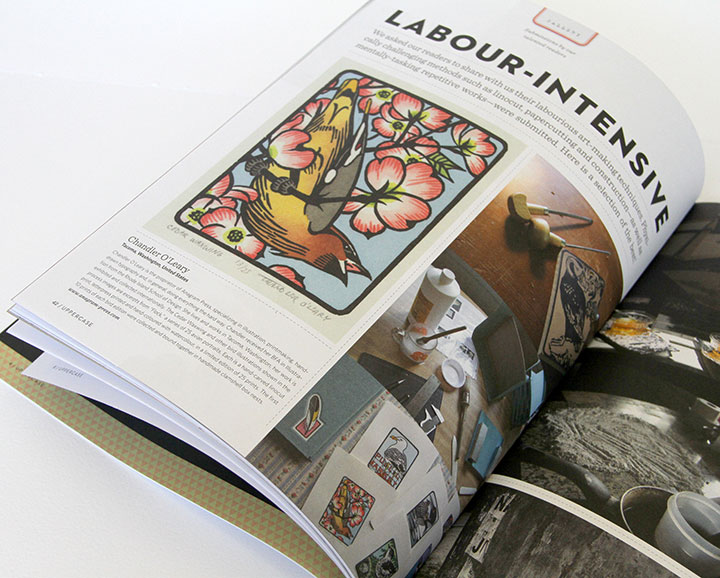
So you can imagine my giddy delight to be included in the latest installment. They had a submissions call for a feature on “labor-intensive illustration,” which was so squarely up my alley that I had to laugh at myself. But I never imagined my little birds would actually be accepted—let alone given a full page. A letterpress colleague received her copy a day or two ahead of me and tipped me off, and I swear I did a little dance around the room.
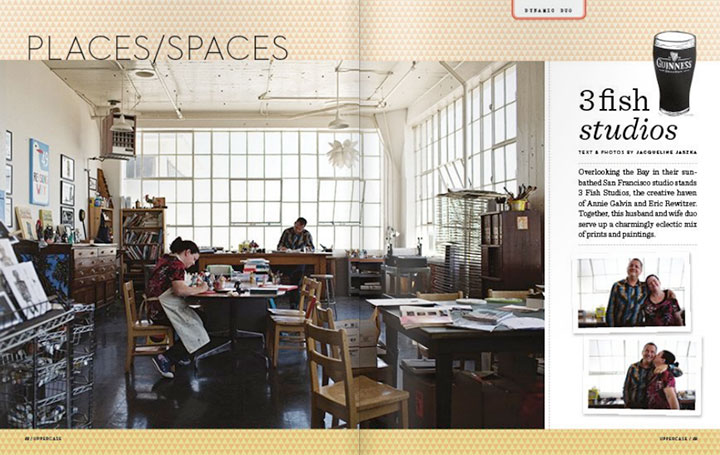
UPPERCASE is the brainchild of a gallery by the same name in Calgary, Alberta. The magazine is tailor-made for anyone with a creative soul; every page is devoted to sharing visual inspiration, shedding light on obscure or vintage art and design work, and detailing the work lives and creative spaces of people who do what they love for a living.
The whole thing is a perfect mix of vintage nostalgia and cutting-edge design, all wrapped up in a sumptuously printed package. If only everything in the world had this much thought and craft behind it.

But my favorite—I mean, favourite—parts of the magazine are the recurring features. There’s an abecedary in every issue, each with a different theme (which does my bookish heart good), as well as a series of collections of vintage objects: bottle caps, cereal boxes, even alarm clocks and fishing lures.
This magazine is truly a thing of beauty, and I hope it’s around for me to keep my subscription going for many years—and issues—to come.
October 30th, 2011
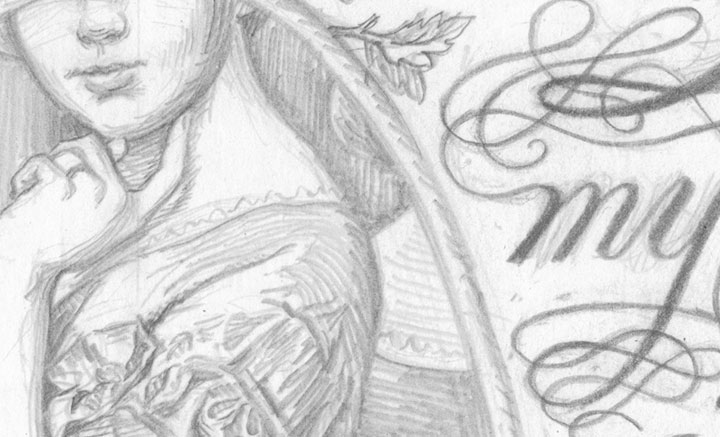
Who is this, I wonder?
You should see the piles of things, er, occupying (hint!) my drafting table this month. You see, Art at Work month is almost here, and I’m scrambling to get ready for all the events coming down the pike.
First up is Studio Tour, that crazy-amazing weekend where it seems like half of Tacoma (the entirely wonderful half, as it turns out) stops by for a visit. This is my third time on the circuit, but our fair city is celebrating its tenth fabulous year of shop crawls and arts extravaganzas. So stop on by next weekend—you can print your own letterpress keepsake (trust me, they’re über cool this year!), pick up free Tacoma swag (better get here early, because it’ll disappear fast), shop for a whole bunch of brand new art and handmade items, and be the first to catch our brand new Dead Feminist, a mystery maiden indeed.
10th Annual Tacoma Studio Tour
Saturday and Sunday, November 5 and 6
10 am to 4 pm, Free!
For more info, full artist list, maps and directions, see here

Look! New stuff!
If you can’t make it to Studio Tour, you can catch a whole bunch of Tacoma artists at the annual Tacoma is for Lovers Craft Fair, put together by the lovely folks at Indie Tacoma and Tacoma is for Lovers. Jessica and I will be sharing a table both days, and it’ll stuffed to the brim with bunly goodness illustrated and letterpress goodies.
Tacoma is for Lovers Craft Fair
Saturday and Sunday, November 19 and 20
11 am to 4 pm, Free!
King’s Books
218 St. Helens Ave., Tacoma
Last but not least, a gigantic virtual heart-shaped thank you to everyone who made a pledge to fund the Apocalypse Calendar! The project is officially a “go,” and we’ll be on press in November. We’re expecting to ship calendars and Kickstarter rewards in early December, and you’ll find calendars in various retail shops this holiday season. If you missed the Kickstarter project, you’ll be able to place online orders here, starting later this week.
Happy Halloween, and see you in November!
October 23rd, 2011
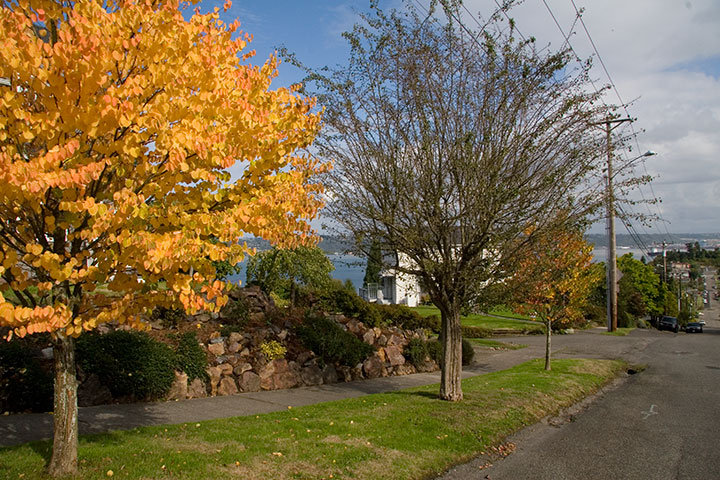
Commencement Bay from the North End, Tacoma, WA

Pumpkin patches, Vancouver Island, BC

First squash haul of the year from Zestful Gardens, Puyallup, WA
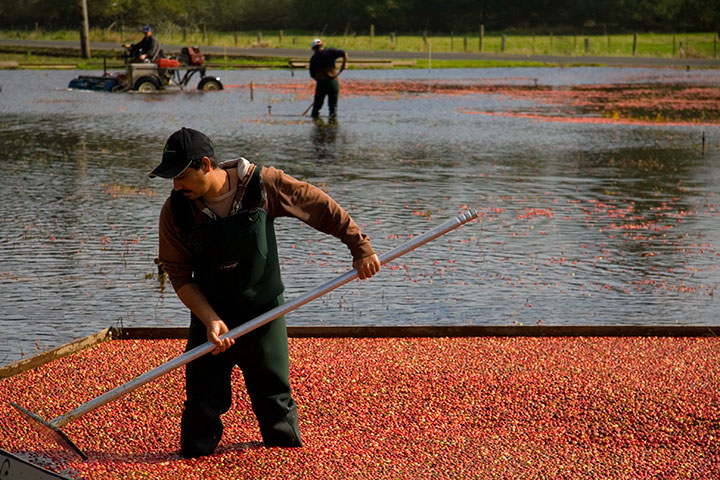
Cranberry harvest, Long Beach, WA
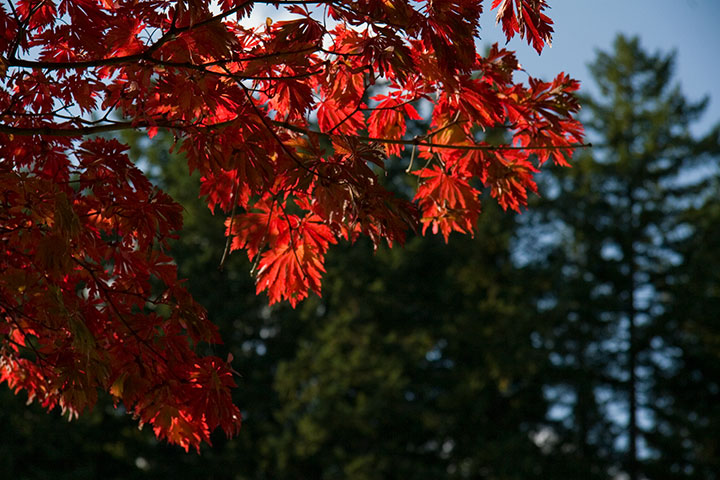
Japanese maple, Butchart Gardens, Brentwood Bay, BC
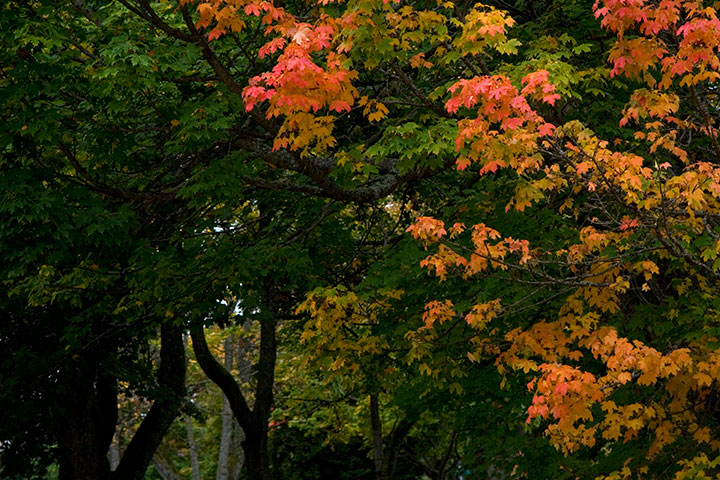
Proctor District in the rain, Tacoma, WA

St. Johns Bridge, Portland, OR
Have I mentioned that I love autumn in the Northwest?
October 17th, 2011
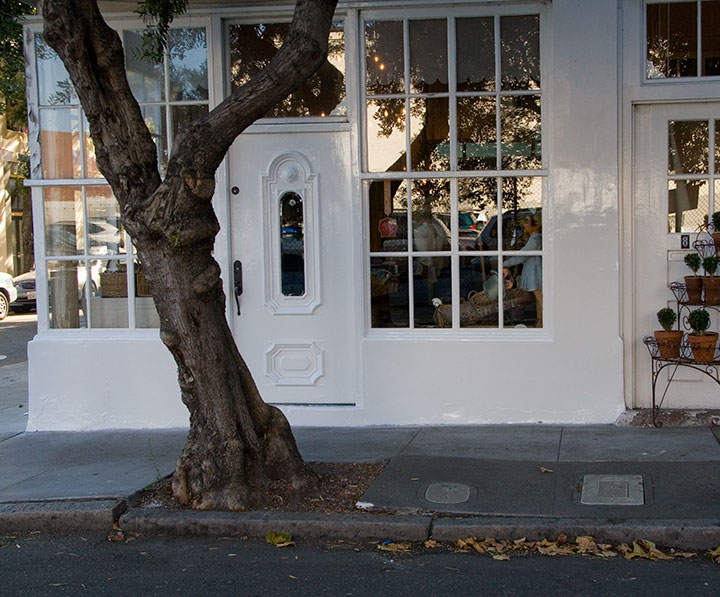
You already know that I have a thing for hidden, quiet spaces tucked away within large cities. So imagine my delight when Jessica turned me onto this place.
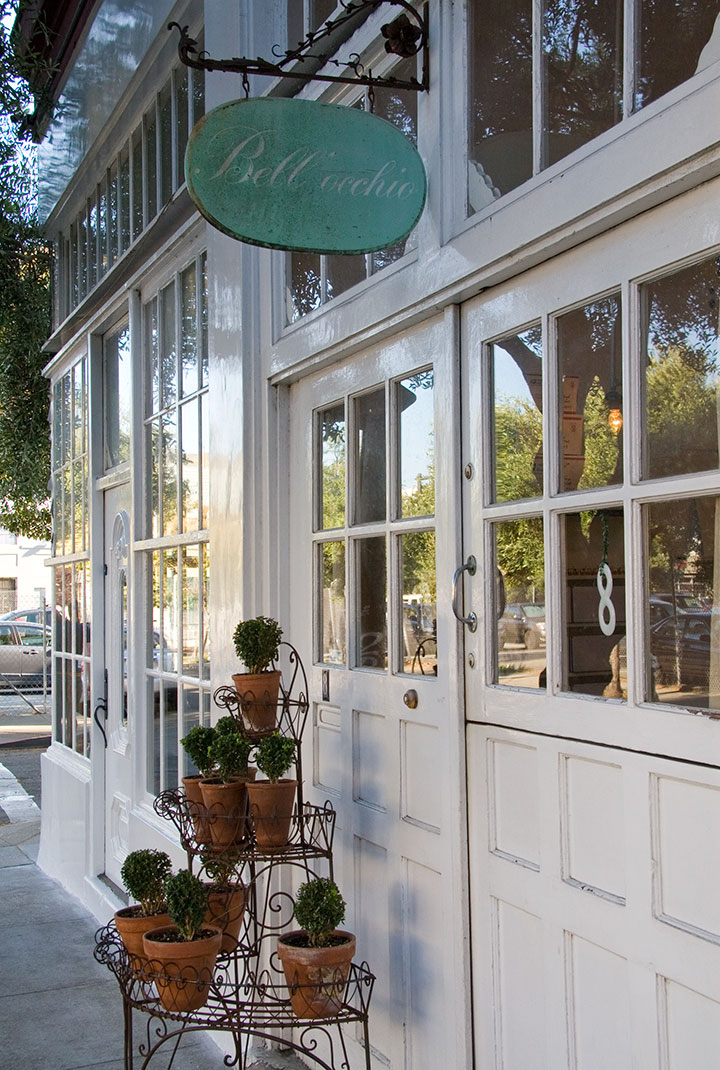
Bell’occhio has quickly become my favorite (and most regularly visited) haunt in San Francisco. It’s easy to miss—it’s just a few steps off of the main drag of Market Street, but the little lane upon which it’s situated is so quiet that it seems transplanted from a different era.
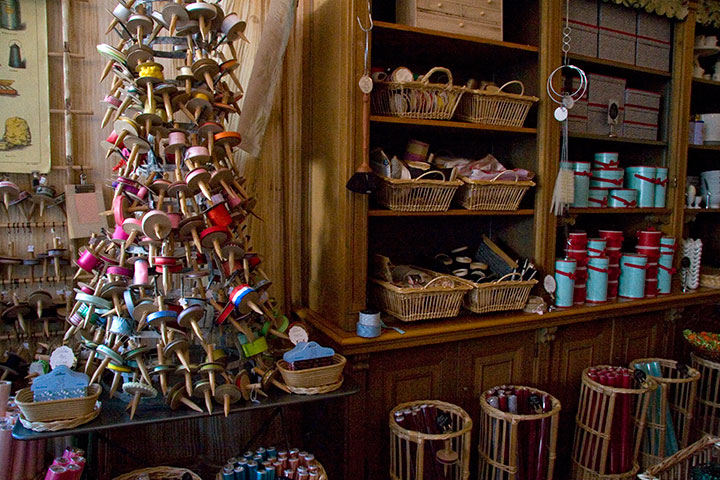
The feeling doubles as soon as you step foot inside the shop. The place is a living, breathing Kunstkammer, with all manner of beautiful odds and ends you never knew you so desperately needed.
My favorite part, though, is the overall presentation. All her inventory is kept in baskets, drawers and wooden cabinets, like a Victorian general store. Each price tag is hand-calligraphed in flowing script. And whenever you purchase something (and I just dare you to visit and not buy something!), your items are packed in vellum envelopes and muslin drawstring bags. Which just about makes me swoon.
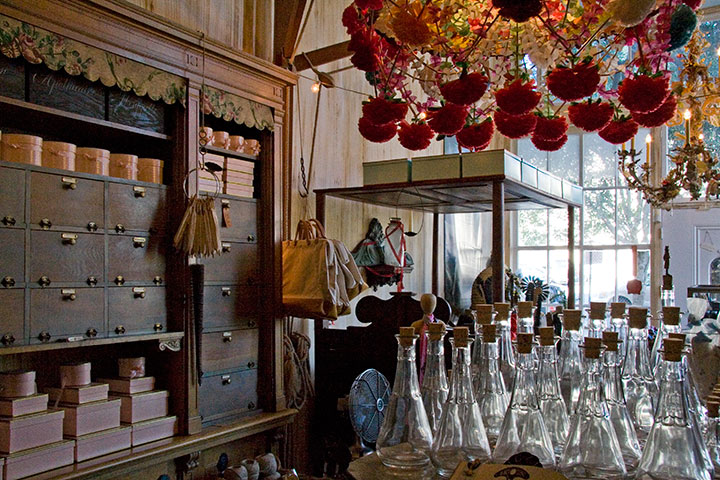
The owner, Claudia Schwartz, was very kind to let me take a few photos and spread the word about the place. She opened Bell’occhio in 1988, but now that this sort of aesthetic is all the rage again, I’m sure she runs a huge risk of having her ideas lifted by copycats. Ever walk into an Anthropologie? I’m pretty sure they stole their whole schtick from her. So Claudia, thank you for allowing me to share your world.

Now, whenever I return to San Francisco, I have a separate Bell’occhio budget—as crazy as that sounds. It’s the one recommendation I can offer if you’re going to come here. Otherwise, this place will have you impulse-buying before you can say, “I’ll take three of those!”
October 14th, 2011
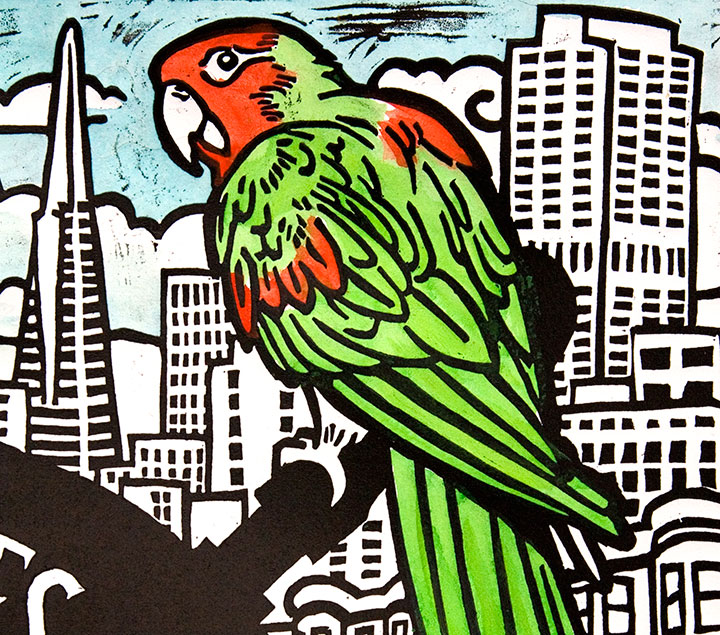
Since I’ve had parrots on the brain for so long, I thought it would make a fitting end to my San Francisco trip to go in search of them. You see, according to legend documented fact, San Francisco has a wild population of feral parrots—if that isn’t nautically themed, I don’t know what is. Yarr!
I’d been told, however, that while popular culture has named them “the parrots of Telegraph Hill,” they didn’t actually spend much time there—so we had no idea where to look for them.
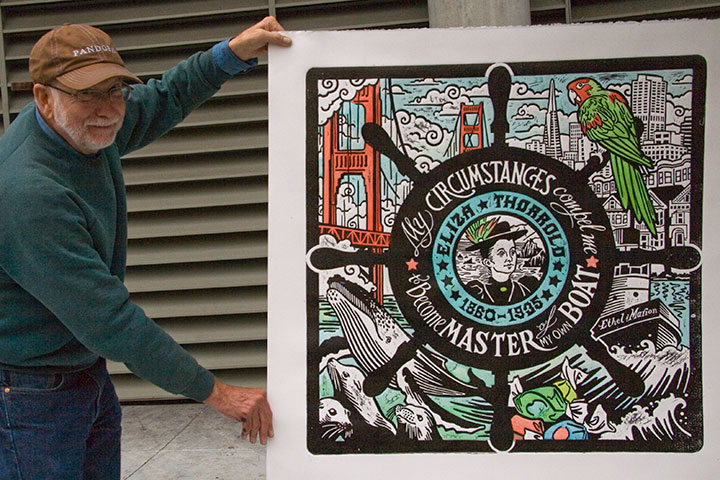
Jessica’s uncle David (pictured here with our print!), who’s lived in SF for decades, came to the rescue. He told me that actually, Telegraph Hill was a good place to look on Sunday mornings in September, and even if I didn’t find any birds, it made for a nice wooded walk.
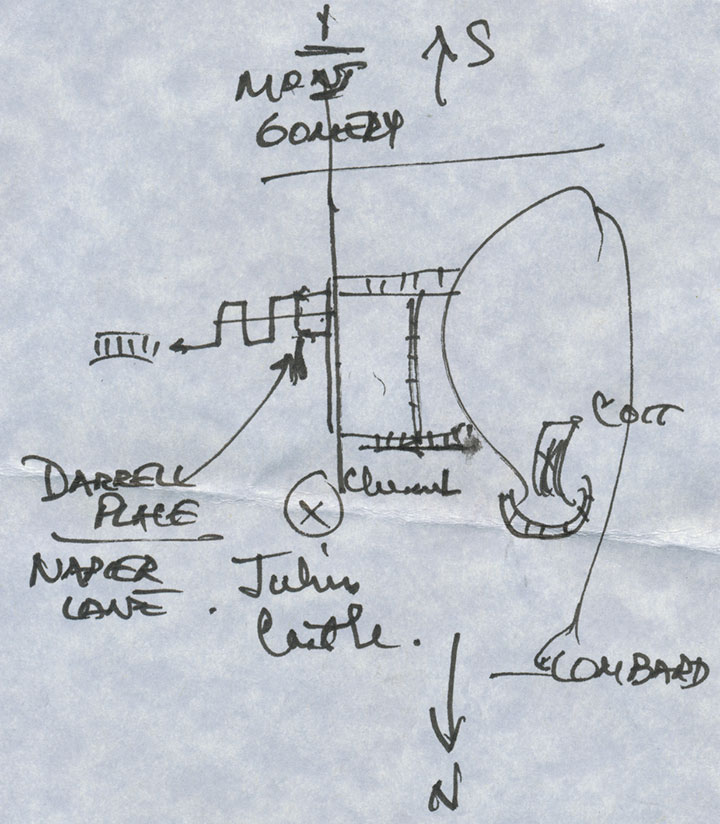
He even scribbled a little map to show me a likely spot. Somehow, that little gesture made the whole thing a hundred times more exciting—I tend to explore cities without atlases or guides (or Googles) anyway, so this little scrap of paper turned a morning hike into a treasure hunt.
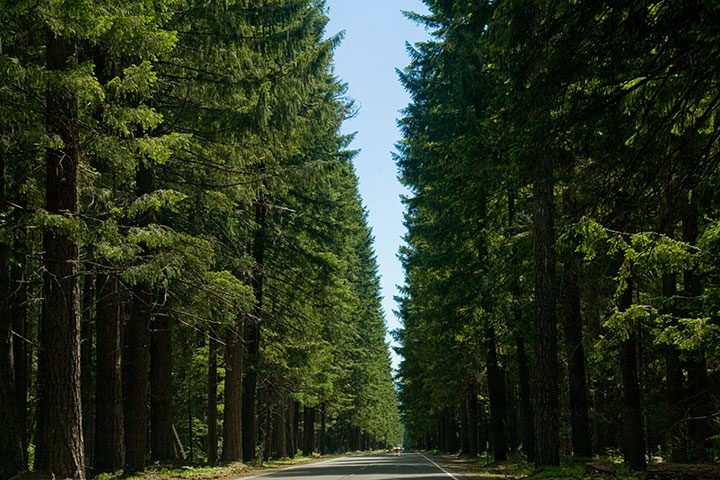
Now, I’m not sure exactly what I was expecting, but I’m a northern gal, so when somebody suggests walking through the woods, this is what pops into my head.
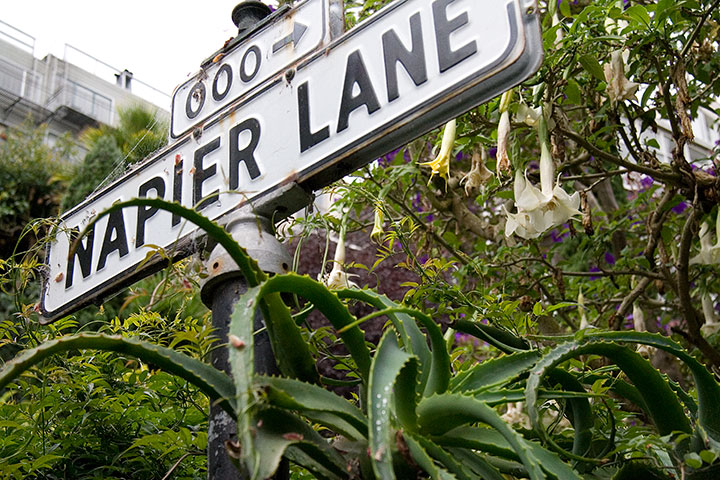
This, on the other hand, was a surprise.
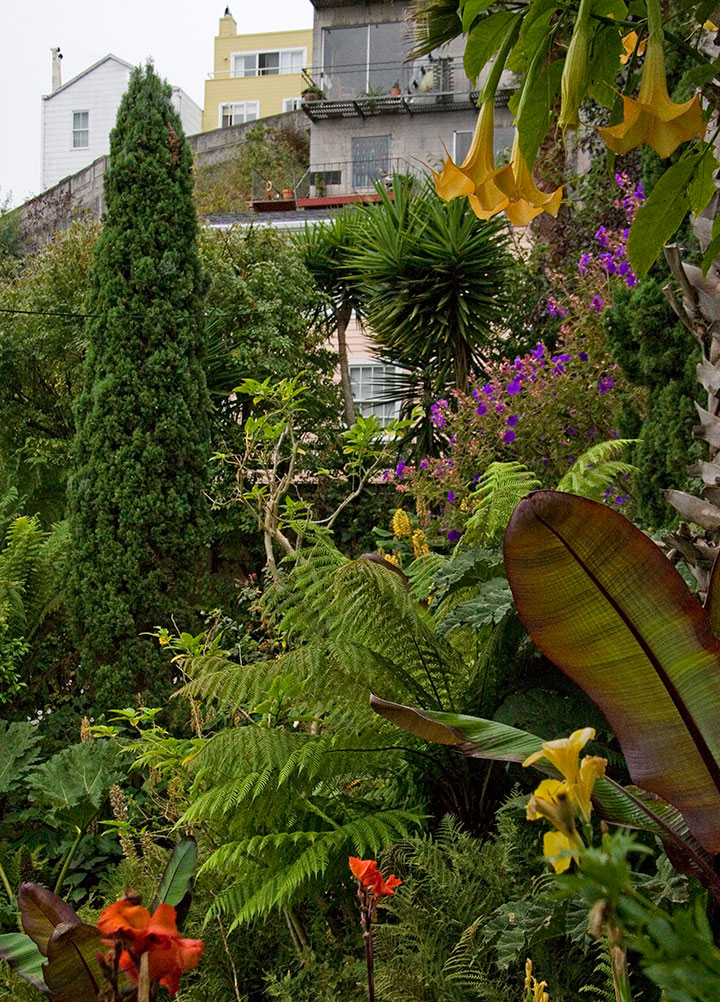
Compared to the mossy pines and cedars in my frame of reference, Telegraph Hill felt like a tropical jungle.
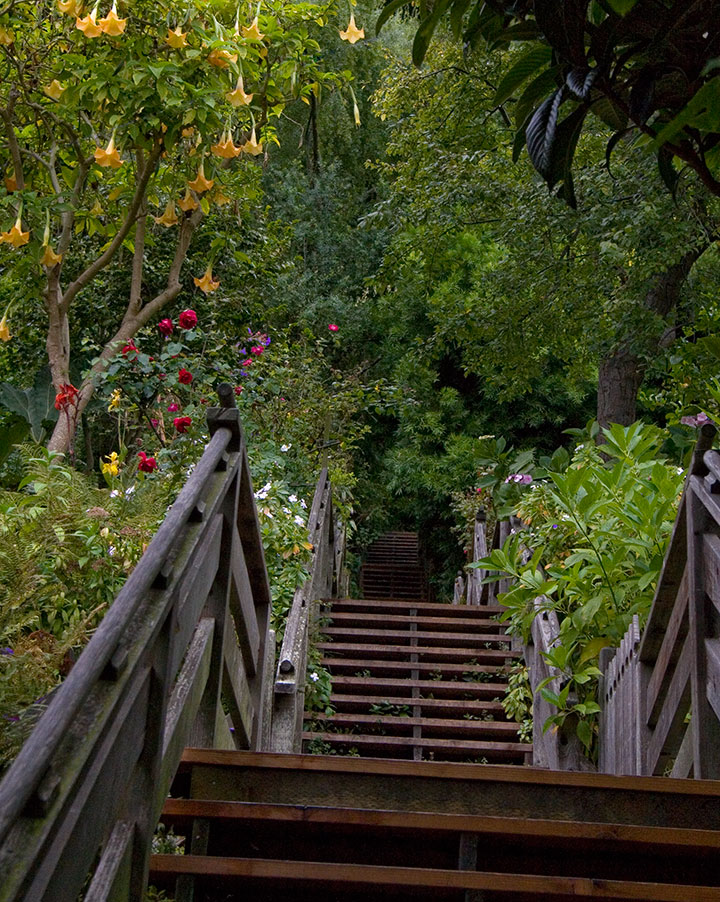
My friends and I had the place almost entirely to ourselves—it was a dark, dreary day, which discouraged all the sun-lovers. So as we wound our way up the steps, it felt like we’d stumbled upon our own private garden, or maybe a path to some other world.
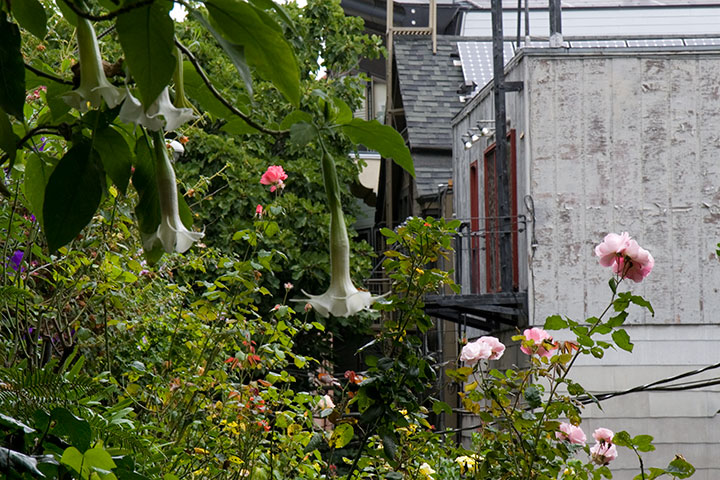
It was easy to forget that we were in the heart of a densely packed city (in California, no less)—this felt more like a secret, slightly English enclave through which we’d been granted safe passage.
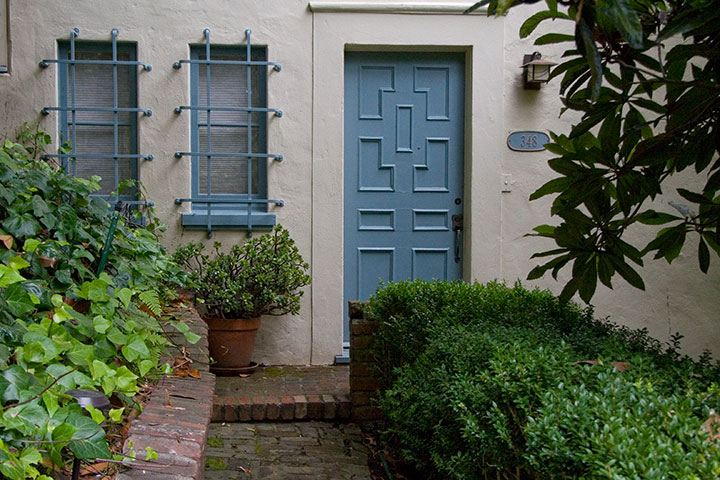
Around every bend was a door, or a courtyard, or another track. Each felt like a gateway to something else, to maybe more and more and more worlds beyond our little slice of perception. It was a hint that what we could see was just the beginning—that what we couldn’t see was out of reach, and all the more tempting for it.
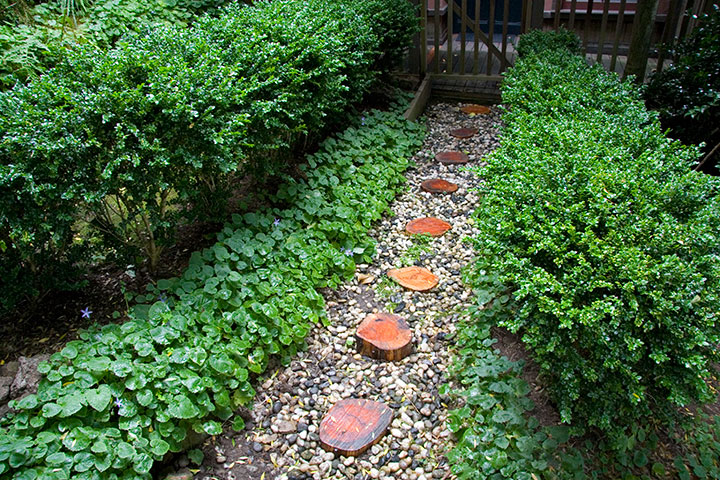
That sort of feeling is just my cup of tea, you know?
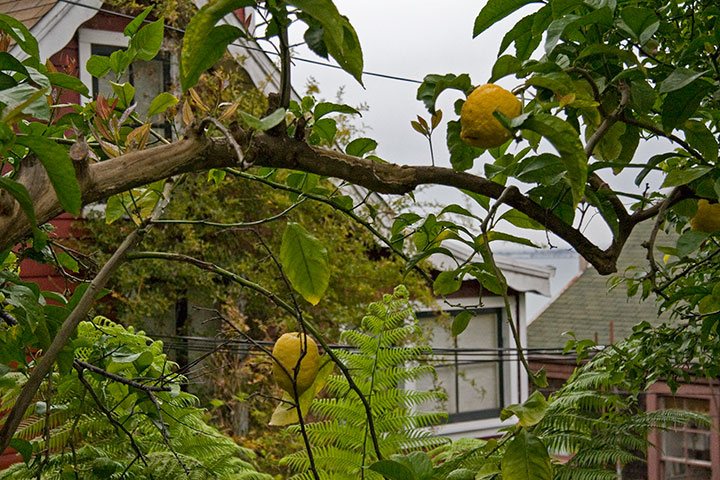
Every time that pleasant disorientation threatened to overwhelm me, though, out popped little hints of where I really was.
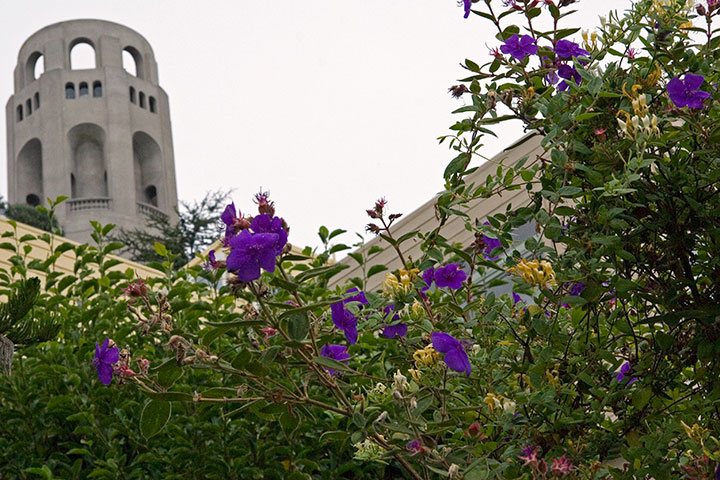
And whenever the trees gave way to open sky, guide posts appeared, showing us the way back—
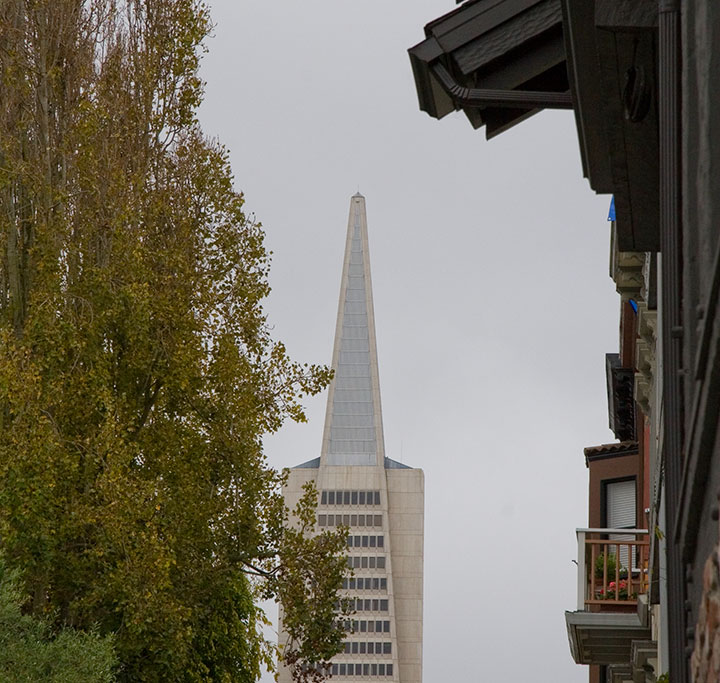
and reminding us that reality was a stone’s throw away.
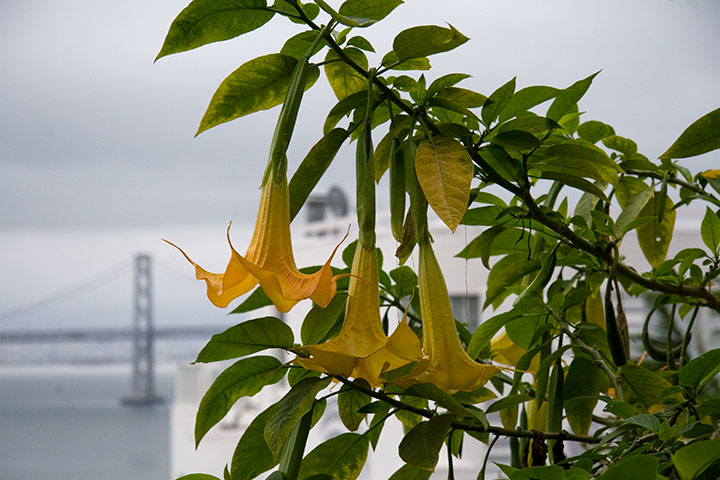
I almost forgot that we were even looking for parrots.
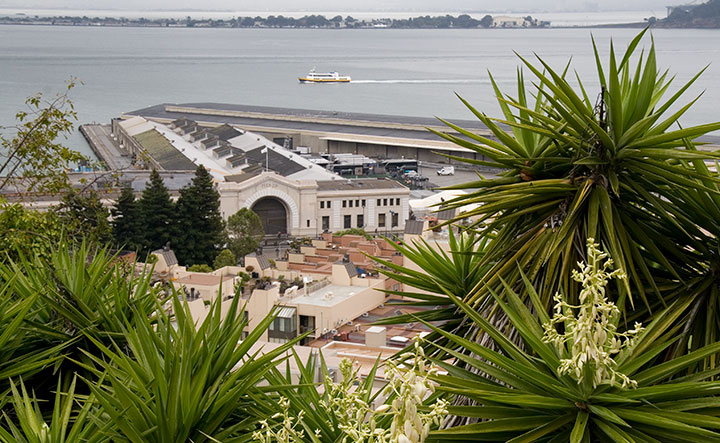
At the top of the hill, we heard a telltale squawking. I glanced up to catch a quick glimpse of two green birds with long tailfeathers speeding away to the west—unfortunately, my shutter finger wasn’t fast enough on the draw.
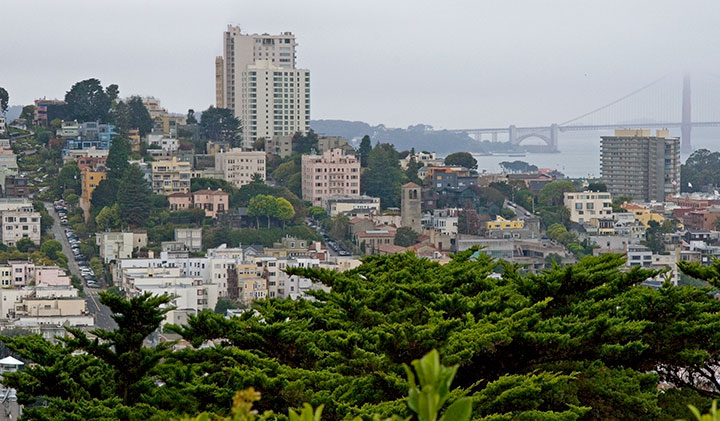
It’s like a ‘Where’s Waldo’ of SF—can you spot Lombard Street? The Golden Gate?
Oh, well. The view alone was the perfect end to the walk.
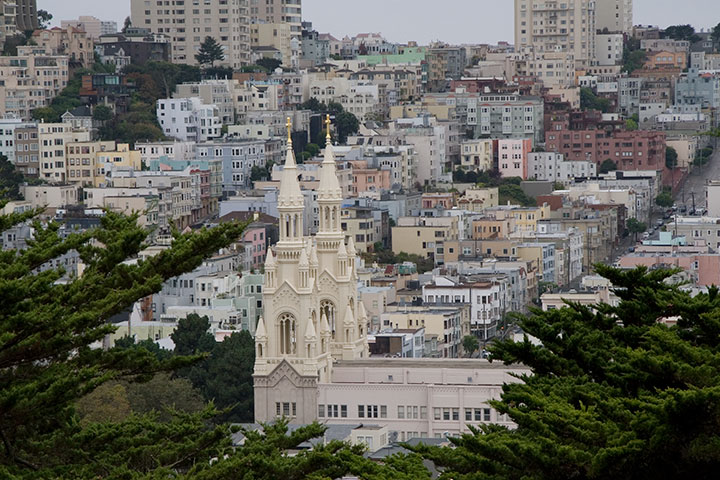
The vista of pastel stucco seemed like a gift, a reward at the end of an uncertain journey. It reminded me of what I love most about the place: that the city itself is like a garden of color—an urban forest in bloom.
* * *
Thank you so much for the amazing response you’ve had to the Apocalypse Calendar! Literally overnight you’ve helped us raise over $1000. We have until the clock strikes midnight on Halloween to reach our goal—thank you for helping us get there!
October 7th, 2011
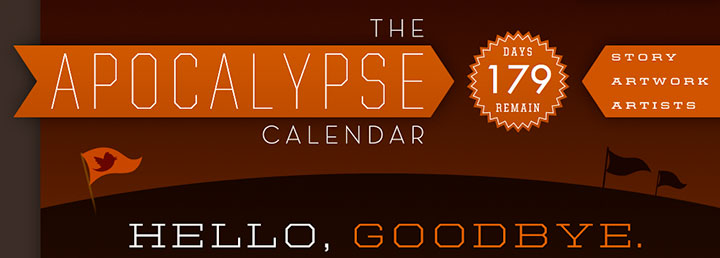
To hear the ancient Mayans tell it, I’d best hurry up with my unfinished projects—because time is running out.
Putting the veracity of such tales aside, this prophecy stuff sounds like a fun illustration topic. So my good friend and old-tyme RISD buddy Thomas Quinn had the ingenious idea to count down our remaining days in style by designing and curating a 2012 Apocalypse Calendar, featuring a different artist for each month. The result of all his hard work (read: herding cats) is a fabulous collection of artwork, a beautifully designed finished product (great job, T.Q.!)—and possibly a niggling sense of dread as the days count down.
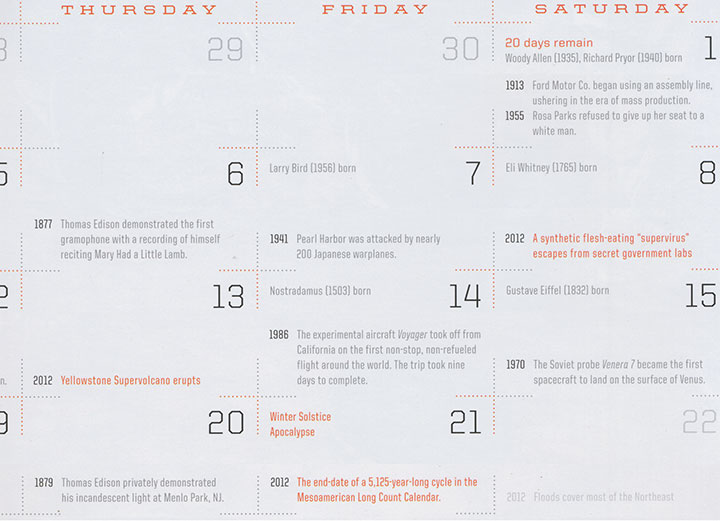
Oh, and here’s a sneak peek of the December page in the calendar—look closely and you’ll see the End Times already conveniently marked for you. Thanks for the heads-up, Mayans!
Besides the added bonus of working alongside both old friends and rock-star artists I’ve admired for years, I loved the fact that Tommy let me interpret the theme however I pleased. Rather than going down the illustrated path of mass carnage or Biblical archetypes (I figured those topics would be well covered by the other folks), I decided to time-travel back to my favorite mass-hysterical era, the 1950s.

I did a little research, and dug up a whole bunch of vintage advice on how to survive the end of the world—including a handbook on how to build a fallout shelter, and how to keep yourself amused once you’re in there.
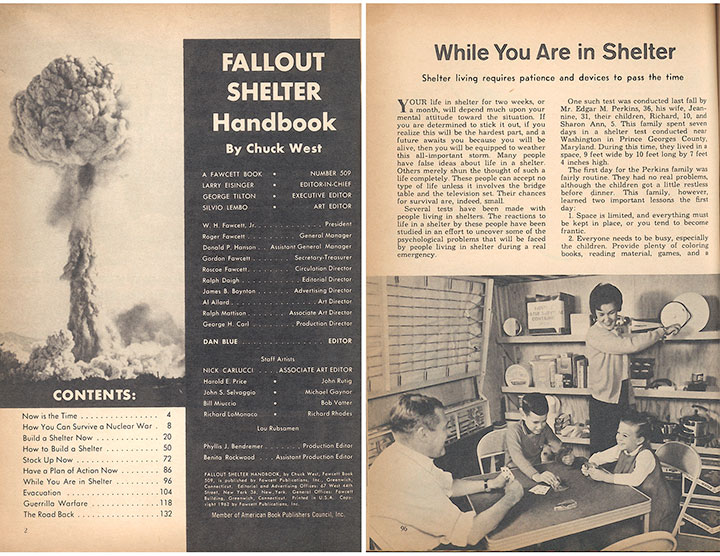
This thing just cracked me up. It has all kinds of “expert” wisdom (like how to fend off the roving bands of contaminated neighbors who will inevitably stop by to borrow a cup of sugar) and cheery photos of housewives preparing dinner with a can opener while dear ol’ Dad bonds with the kids.

Which, of course, reminded me of my other favorite relic from the 50s: illustrated cookbooks. Talk about a goldmine! Everybody from uncredited production interns to the late, great Charley Harper did a cookbook back in the day. The fact that these illustrators were often limited to cheap, two-color printing actually made for surprisingly innovative and beautiful results.
And of course, as you already know, I am completely fascinated by the sheer number of terrifying Jell-o recipes and ill-advised casseroles that crop up in old cookbooks. And since that got me thinking all sorts of wonderfully twisted things about housewives at the End Times, and how Jell-o can probably survive a nuclear holocaust, I decided to combine the two.
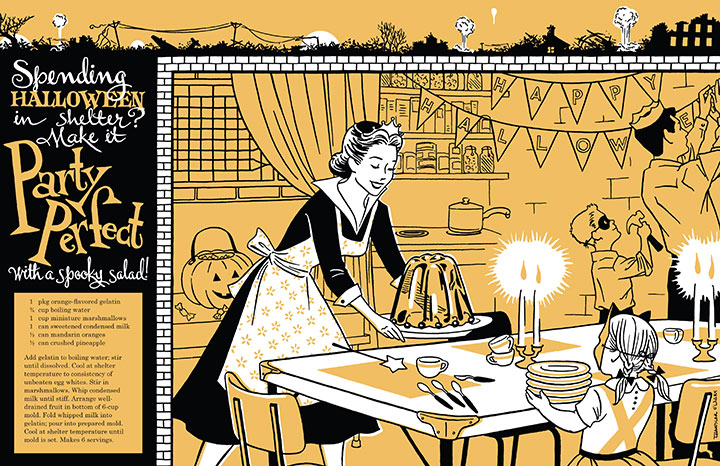
So here’s my contribution to the calendar: how to bury your head in the sand, in style. I asked Tommy for October, since it’s my birthday month, and he was kind enough to oblige. So I went nuts with the pumpkin orange and threw a Halloween party.

Complete with absurd salad recipe (that you could actually make, but I wouldn’t advise it), shelter decorating hints—

—and just a little untold destruction, for garnish.
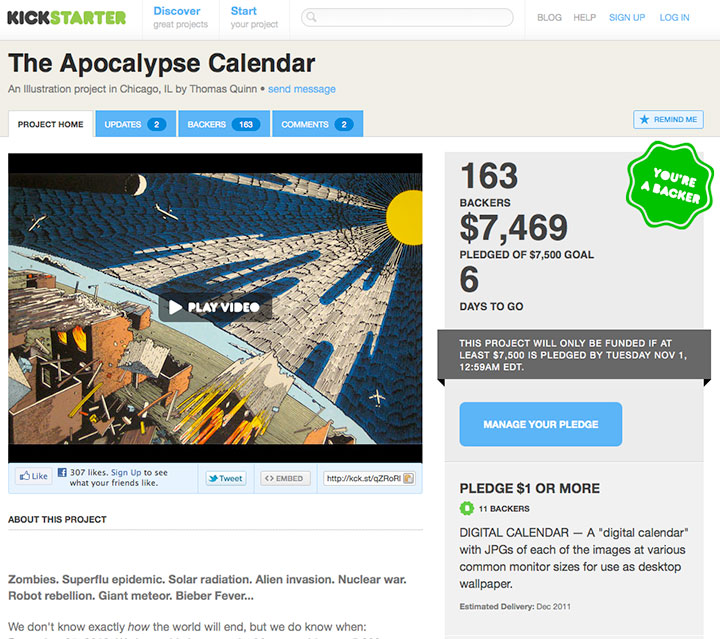
Illustration by Jay Ryan
We decided that spiffy, large-format, high-quality offset printing is the best way to show off the artwork, so we’ve set up a Kickstarter project to fund the thing. (We even put together a nifty and hilarious video!) Kickstarter is a fairly new phenomenon, and it’s proven to be a wonderful resource for artists, especially—and since the Kickstarter logo uses the same font as the Dunkin Donuts logo, it makes my designer’s lizard brain happy.
Kickstarter works the way an NPR pledge drive does—you get various gifts in return for your support amount. Twenty bucks will buy you a calendar, and there are a bunch of goodies available at other pledge levels, like signed calendars, original art, and even the ability to make the artist of your choice do your bidding and draw your apocalyptic portrait. (Yes, you read that right.) If we meet our goal, we’ll be shipping calendars in December.
Now, the tricky thing about Kickstarter is that it’s an all-or-nothing kind of thing. If we don’t make our set funding goal by the time the clock runs out, the apocalypse will come early we don’t get any of the moolah pledged so far. So pretty please, do us a huge favor by doing your annual calendar shopping a wee bit early—you can make your pledge here.
After all, if the Mayans have their facts straight, this is the last calendar you’ll ever need to buy, right?
October 5th, 2011
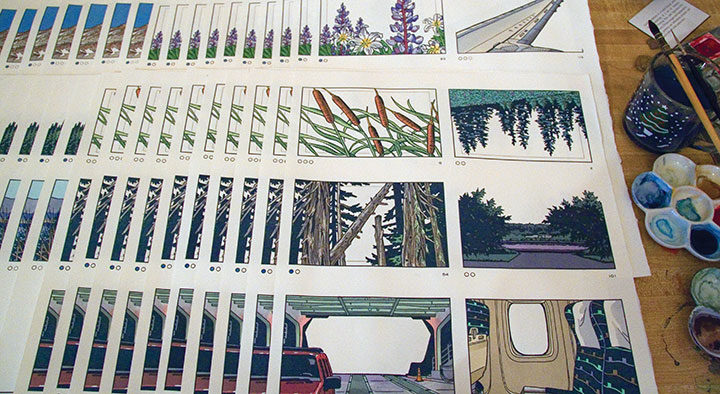
Just wanted to give you a peek at what the studio looks like these days. I try not to think about it too hard, because I officially unveiled the thing almost a year ago, but I’m still working on my book.
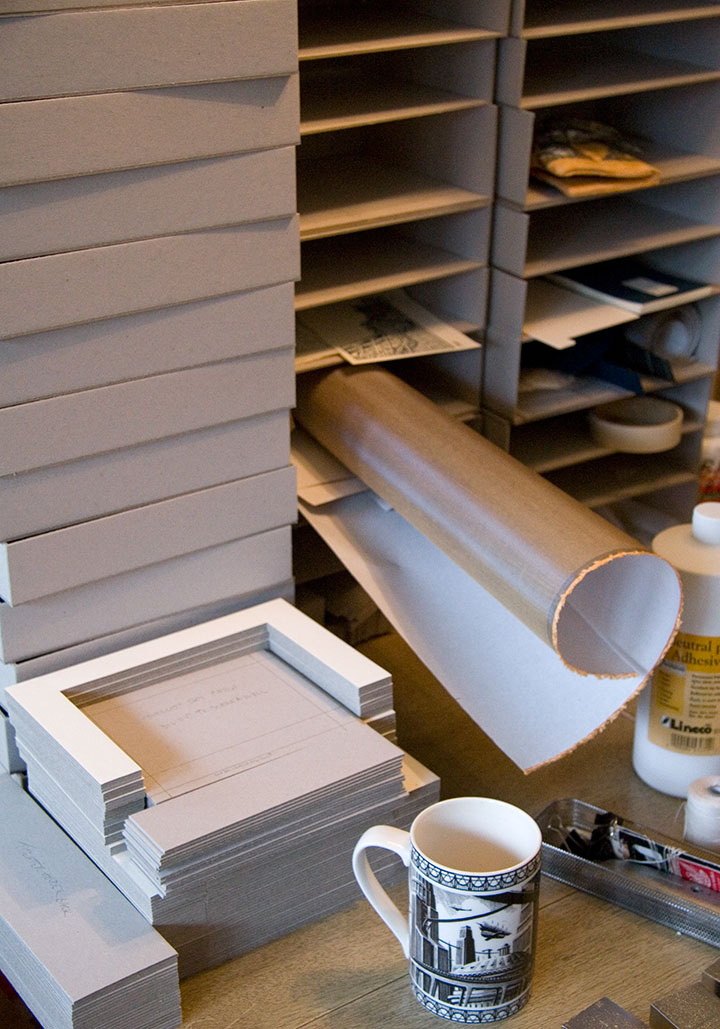
Big dang pile of box parts; coffee cup for scale.
You see, it’s one thing to get the prototype done for the exhibition, but when you’re making an edition of books, that means you have to finish all the rest of the copies, too.
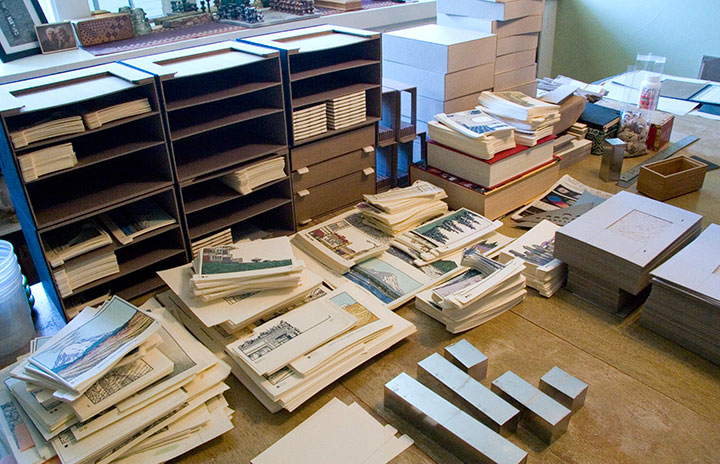
Obviously, I have my work cut out for me.
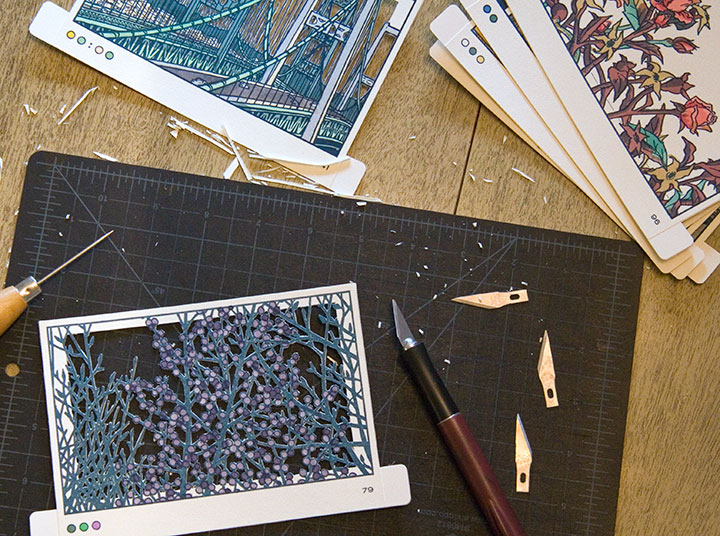
October 1st, 2011
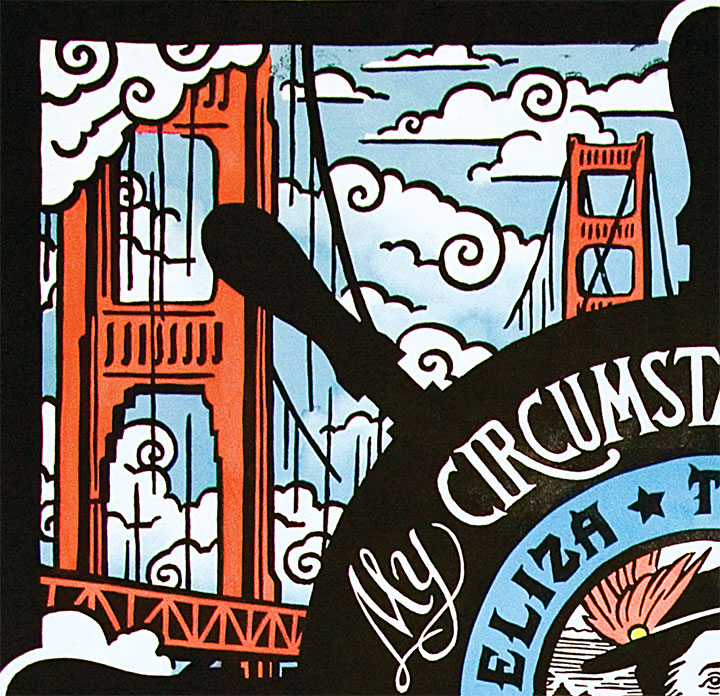
It’s hard to think of a better weekend activity than taking a quick trip to San Francisco.
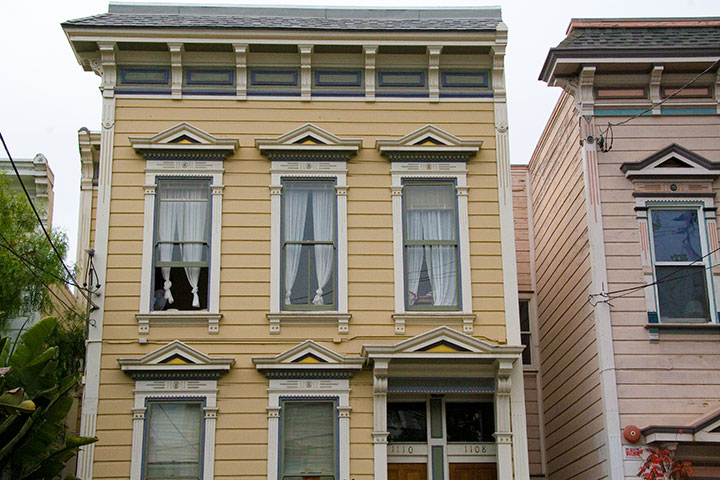
First of all, Jessica and I got to visit the lovely Sarah and Jesse, who live here—
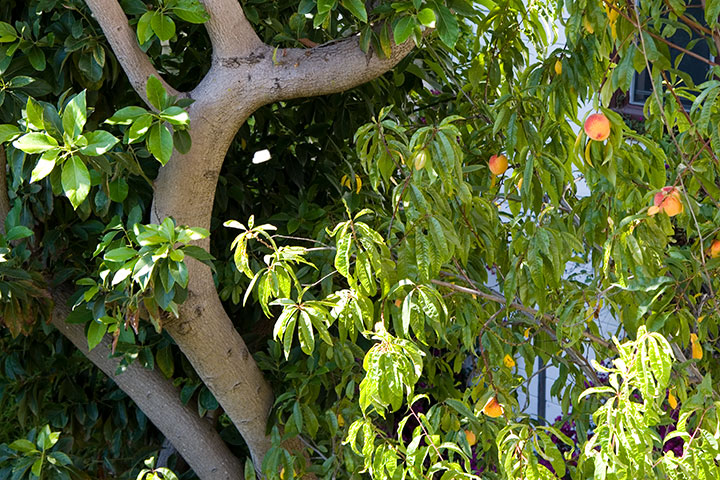
and whose back yard contains this.
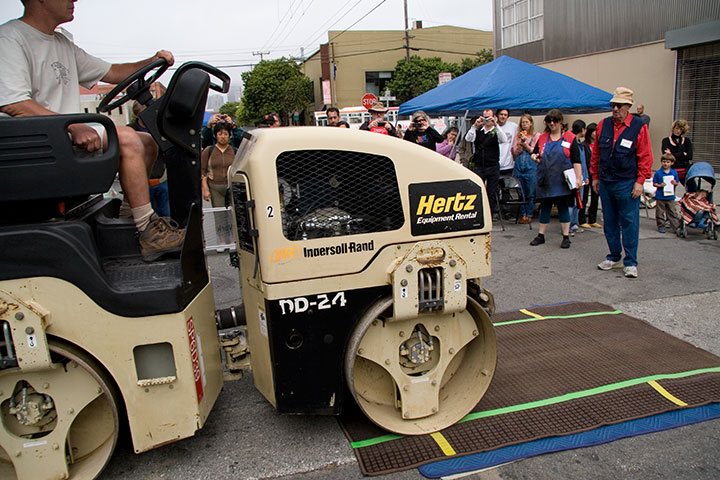
And then we got to raise a fantastic ruckus and make guerrilla street art with a whole bunch of people looking on.
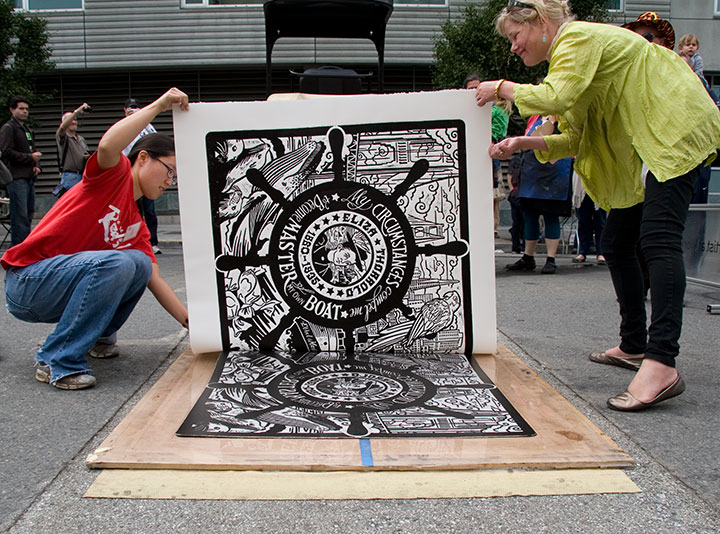
SFCB’s got this thing down to a science. Between the small army of volunteers who took care of the inking and registration (line-up),

and their probably-patented methods for keeping street schmutz off the prints, the results were impressive. In fact, this is my fourth steamroller print (and Jessica’s fifth), and I’ve never seen one turn out this well before.
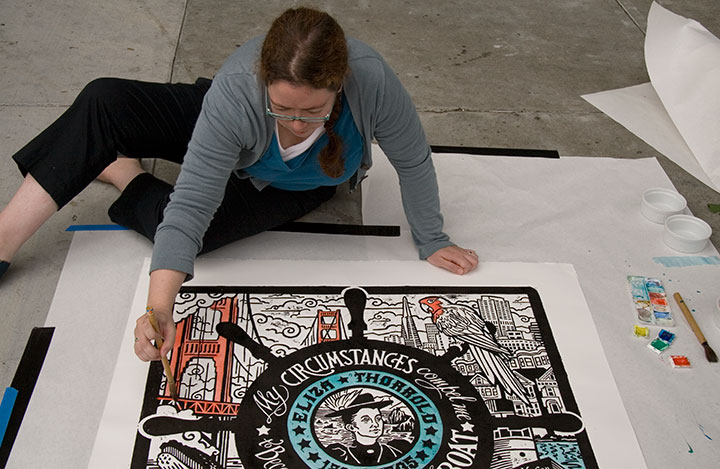
Photos of us by Jesse Mullan
Besides, we really needed to keep our hands clean this time, because we upped our personal ante and just plunked ourselves down on the sidewalk for a bit of on-the-fly hand-coloring (though avoiding the very wet ink felt kind of like playing Twister).
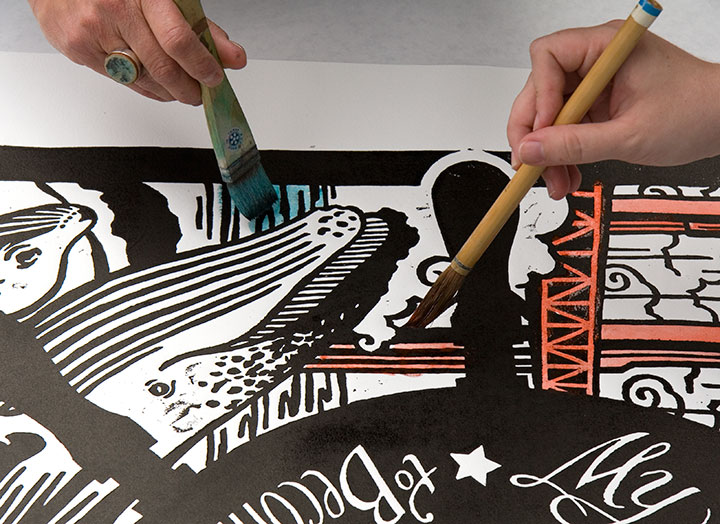
That turned out to be the perfect tag-team job, actually. I do a lot of hand-coloring when I print, as you know, but never anything this big—
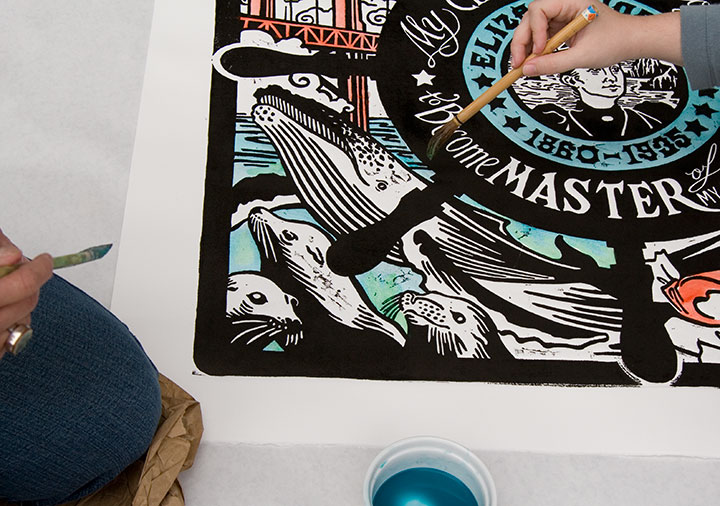
having two sets of hands to blend colors and two sets of eyes to look for missed spots was definitely the way to go.

So thar she blows. Let me introduce you to Eliza Thorrold, and our latest honorary Dead Feminist print, Even Keel. Eliza was the first licensed female tugboat master on San Francisco Bay. After Charles, her husband who piloted the Ethel & Marion before her, died an untimely death, she fought for and received her operator’s license to continue their tug business in his stead and provide for her family. Her quote says it all: “My circumstances compel me to become master of my own boat.” Hear, hear, Eliza.
After she left the high seas and entered retirement as a landlubber, she became master of her own taffy pull by opening a successful ice cream and candy shop with her son. Hence all that salt water taffy. And as if the nautical sweet-shop theme weren’t enough, we couldn’t resist throwing in all our favorite things about San Francisco. So go hunting around the image, and see what you turn up. Then, on your next trip to the City by the Bay, learn more about Eliza’s life (and those of other women mariners) at San Francisco Maritime National Historical Park.
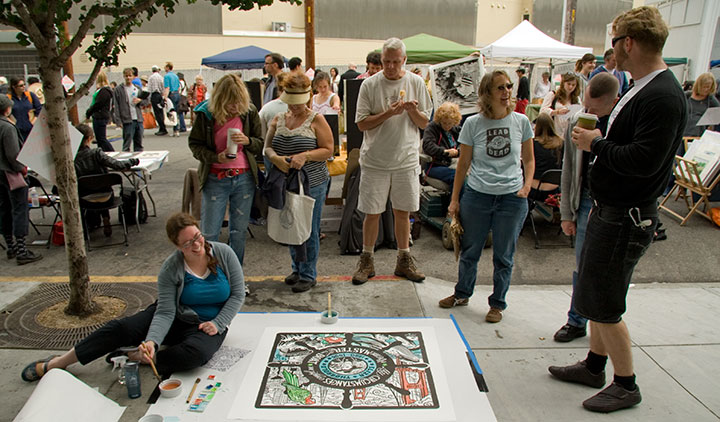
So, yeah. It might not fit the traditional idea of a productive weekend, but it’ll do. We came away with new friends, blue fingertips and a whole lot of ideas to make our own humble little steamroller party better.
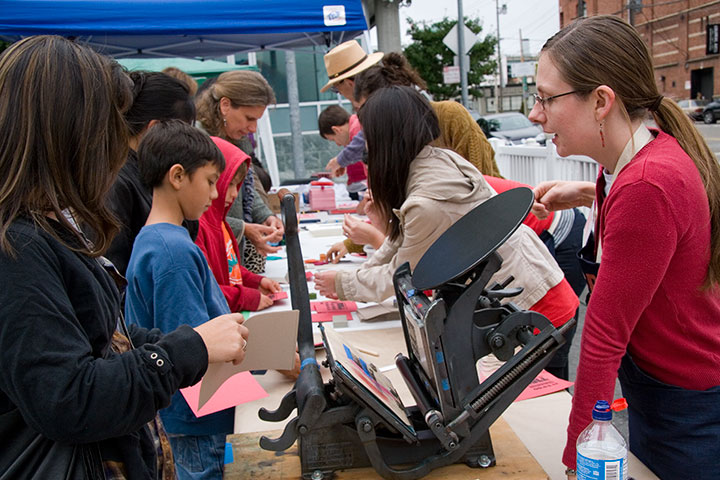
Many thanks to all the staff and volunteers of the San Francisco Center for the Book, who made the day a smashing success—
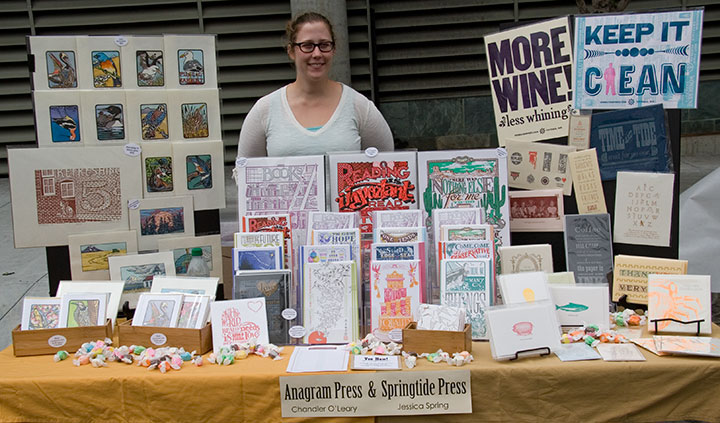
and to all the kindred spirits who lent a whole bunch of helping hands. Like the super-nice TSA employee who took such great care of our linoleum block and didn’t bat an eye that we had to bring something so huge and bizarre onto an airplane. Like Sarah, who manned our table; and Jesse, who shot most of the photos; and the huge, huggable posse of Jessica’s extended family, who helped schlep things and kept us company and bought us beignets. And especially Jessica’s ten-year-old niece, Luciana, who basically designed our table arrangement. ‘Ciani, you’re one awesome ragazza.
And of course, to Eliza—thanks for standing proud at the helm.
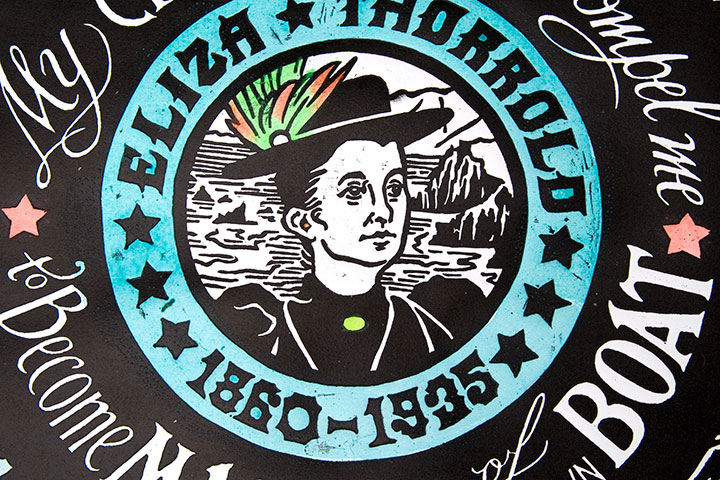

![Chandler O'Leary [logo]](https://chandleroleary.com/wp-content/themes/chandleroleary/images/logo.png)









































































